A clean sandbed in a saltwater aquarium can greatly enhance the health and aesthetics of your aquatic environment. To achieve this, incorporating sand-sifting goby fish can be a natural and effective solution. This guide introduces eight different species of sand-sifting goby fish that are excellent choices for maintaining a clean sandbed in your aquarium.

Having a clean sandbed in your saltwater aquarium can sometimes seem like a distant dream.
Fortunately, I did some research to provide you with a list of sand-sifting goby fish that would stir the substrate in your tank in search of food or when digging holes to live in.
This activity would help keep your sandbed free of small food leftovers and other organic particles that may otherwise spoil the quality of the water in the system.
Sifter gobies also help with aerating the sandy bottom, preventing harmful gasses from building up underneath.
That being said, let me show you the 8 sand sifting goby species that could keep the substrate in your aquarium sparkling clean.
8 Sand Sifting Goby Fish That Will Keep Your Sandbed Clean
While doing research for this list, I made sure to only pick gobies that are known to do an exceptional job at turning over sandbeds.
However, keep in mind that different goby species have different activity levels and so would suit tanks with different bottom footprints.
Also, though tank-raised specimens may accept prepared foods such as frozen brine shrimp, spirulina, or live worms, these types of fish feed on the microfauna within the substrate. As such they require a mature tank to thrive.
For this reason, in most cases, you’d want your aquarium to have been up and running for at least a year before introducing the sifter.
Keeping sandbeds clean is extremely important for the well-being of aquarium inhabitants and the environment. However, the sandbed often becomes dirty and suffocating due to the accumulation of filth like detritus, algae, and trapped dangerous gasses. If these are not resolved promptly, they pose a serious threat to the health and wellness of aquarium inhabitants.
Detritus is the primary cause of dirty sandbeds, composed of dead organic matter such as uneaten food, fish waste, rotten plants, etc. Due to detritus, there will be an increase in nitrate, ammonia, and nitrite, which are detrimental to aquatic species.
Hence, the use of effective detritus removal in saltwater aquariums is important. Utilization of sand-sifting goby fish is a great option when maintaining a clean and healthy sandbed and combating cyanobacteria.
Algae outbreaks are another big issue for aquatic life due to sandbeds becoming dirty. Excess nutrients in the water and bad lighting conditions favor algae growth, which not only interferes with aquatic life but also reduces the aesthetics of the aquarium.
Gasses trapped in aquariums such as hydrogen sulfide are a big challenge for the health of aquarium species. Anaerobic bacteria in tanks produce hydrogen sulfide by breaking down the organic matter in the absence of oxygen, which has a fatal impact on the health of aquatic life.
To deal with such challenges aquarists often resort to using natural aquarium cleaning agents like sand sifting goby fish that can clean sand beds naturally.
Sand-sifting gobies, consisting of species such as Diamond Goby and yellow Watchman gobies play important roles in cleaning the aquarium and keeping it aerated.
These gobies have characteristic anatomical structures such as mouthparts and behavior which allow them to sift through the sand, eating detritus, leftover food, and algae in aquariums.
Here is a look at the sand-sifting goby fish that could help clean your saltwater aquarium sandbed:
1. Diamond Goby – Valenciennea puellaris
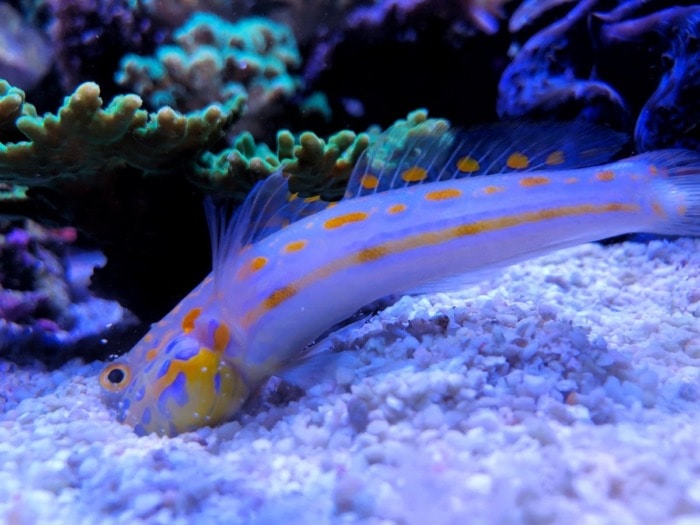
| Maximum Body Size: | 6 inches (15.2 cm) |
| Minimum Tank Size: | If the Diamond goby does not rely solely on sand sifting for its diet, then a 30-gallon tank would be the minimum |
| Key Traits: | Is an absolute machine for moving sand; a great jumper; very active |
| Suitable for Beginners: | Some experience and a certain setup are required to keep them long-term |
The Diamond Goby from the Valenciennea genus is a very popular sand-sifting fish, mainly because it’s so good at what it does.
This species of goby does its job a little too well.
A sand-sifting Diamond Goby may constantly move sand around and sprinkle particles all over the corals you keep on the bottom. You’d likely need to blow them off once or twice a week or simply reposition them.
Users who keep Diamond gobies sometimes complain that the fish creates sandstorms in the tank.
A cloudy aquarium is not great to look at, but it should eventually get filtered by your mechanical filtration media.
So, if this fish is so messy why would I recommend it then?
Diamond gobies make excellent sand sifters for large saltwater tanks of 100 gallons or more.
The goby itself is not aggressive but grows large enough not to get eaten while keeping the sand it sifts through sparkling clean.
Following these thoughts, a large, mature tank with no corals on the bottom makes the perfect habitat for this sand goby species.
In addition to their cleaning properties, Diamond gobies are renowned for their active nature and engaging behavior. These fish consistently sift through the sand in search of food.
They are energetic which is not only good for cleaning but also adds a visual appeal for aquarists, observing them darting and moving along water currents in a captivating and fascinating manner.
Furthermore, Diamond Gobies exhibit striking visual characteristics, their sleek, elongated bodies and vibrant coloration, featuring shades of white, yellow, and brown, stand out against the backdrop of the sandy substrate. The distinct diamond-shaped markings on their bodies further enhance their attractiveness.
Considering Black Diamond blasting sand? Explore its aquarium safety and advantages here.
2. Court Jester Goby – Koumansetta rainfordi

| Maximum Body Size: | 2.8 inches (7.1 cm) |
| Minimum Tank Size: | mature tank that hold 10 or more gallons |
| Key Traits: | Peaceful; stays small; should be captive-bred for long-term success |
| Suitable for Beginners: | No, you should find tank-raised specimens and think through their tank mates |
The Court Jester Goby, also known as Rainford Goby, is a peaceful nano fish that can sift through the fine sand in your small saltwater tank. These fish don’t have large mouths, so a single specimen won’t do a good job at turning over the substrate in tanks over 20 gallons.
The Court Jester goby fish belongs to the Koumansetta genus.
In any case, they would only sift through the top layer of the sand and won’t bury your corals on the bottom.
Apart from sand sifting abilities, the court Jester Goby feeds on certain types of algae , keeping algae growth in your aquarium in check.
Beginner-friendly goby species, such as the Yellow Watchman Goby, offer bright colors and easy care, making them ideal for novice aquarists.
Another interesting aspect of the Court Jester Goby is its ability to be bred while in home aquariums. Captive-bred species are readily available in the aquarium trade, which not only ensures their availability but also increases their likelihood of success in your home aquarium. Captive-bred gobies are typically more adaptable and can adjust to new aquarium conditions and environments.
Captive-bred species are among the truly nano reef-safe goby fish known as the hobby.
For this reason, the Court Jester goby can be an excellent sifter for a nano reef tank.
Author’s note: Wild-caught Court Jester Goby fish are very finicky eaters. Even a mature sand bed with a lot of copepods and microalgae may not be enough to keep the fish alive in the long run.
For this reason, I recommend only getting captive-bred gobies who will readily accept prepared food when the sand runs out of nutrients.
Live black worms are always an appreciated treat.
Suggested read: Fish Ideas for a 5-Gallon Saltwater Tank
3. Blue Dot Goby – Valenciennea sexguttata

| Maximum Body Size: | 5.5 inches (14 cm) |
| Minimum Tank Size: | 30 gallons |
| Key Traits: | Active; not messy; peaceful; can be paired, but will be aggressive towards its kind otherwise; will dug burrows |
| Suitable for Beginners: | No |
The Sleeper Blue Dot Goby (Valenciennea sexguttata) will keep the sand in your tank sifted without spreading it all over the rockwork. This goby fish reaches about 5.5 inches when mature, which makes it a perfect addition to a 30 to 50-gallon tank with a deep, mature sandbed.
The Sleeper Blue Dot Goby will methodically scoop sand while carefully releasing it at pretty much the same spot.
When raising Blue Dot Gobies, it is important to consider the presence of a deep and good sand bed. These fish are burrowers, and they depend on a deep substrate to exhibit their natural behaviors.
With a deep sand bed, it is also crucial to provide stable rockwork when keeping Blue Dot Gobies. They often seek refuge within rocks and crevices, where the stable rock formation provides them with a hiding spot and protection.
Despite their borrowing tendencies, blue dot gobies are generally peaceful and tranquil creatures and prefer to coexist harmoniously with other tankmates.
Therefore, they are appropriate for community aquariums like goby medium tanks containing other peaceful species, including small to medium-sized fish and compatible invertebrates.
Author’s note: One thing to be aware of when keeping this saltwater fish is that it will dig multiple burrows for itself. This means that your aquarium rocks should not rely on the sand to stay in place. Just position them in such a way that if a hole is dug under, the rock won’t collapse. Note that all the above points are important for sand sifting goby care.
4. Orange Crosshatch Goby – Amblygobius decussatus
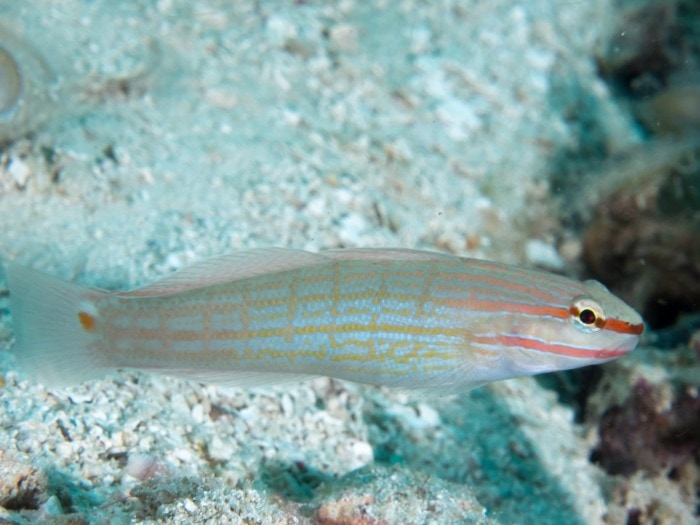
| Maximum Body Size: | Around 3.7 inches (about 9.5 cm) |
| Minimum Tank Size: | 25 gallons or more |
| Key Traits: | Simplistic but attractive-looking fish; a moderate and subdued sand sifter; peaceful; remains relatively small |
| Suitable for Beginners: | No |
Coming from the Amblygobius genus, the Orange Crosshatch Goby is one of the best sand-sifting species of fish to keep the sand in your 20 to 30-gallon nano tank aerated and clean.
It sifts less aggressively than the Sleeper Blue Dot Goby, but enough to maintain the bottom free of debris.
The Orange Crosshatch Goby would leave the processed sand roughly where it has picked it from. This goby species does not grow more than 4 inches in adult size and is, therefore, one of the best sand sifters for small reef aquariums.
The Orange Crosshatch is the best choice for nano aquariums. The small size and tranquil demeanor enable it to be suited for small-size tanks, increasing both the functional and aesthetic appeal of the aquarium.
This sand sifting goby is well known for its gentleness in sifting which helps to maintain the substrate surface clean without causing disruption in the tank environment.
A fun fact about the Orange Crosshatch Goby is its relationship with pistol shrimp. In their natural habitat, the Orange Crosshatch Goby forms a symbiotic relationship with pistol shrimp, where the shrimp excavates and maintains a burrow while the goby acts as a lookout. This interesting behavior can also be observed in an aquarium!
Due to its distinguished orange and white crosshatch pattern, it is called the Orange Crosshatch Goby. This appearance and pattern within this colorful sand sifter goby gives a visually appealing aesthetic to the aquarium.
Furthermore, its slender body and graceful movements make it a captivating addition to any reef tank, where it shows itself to be a reef-safe goby, guaranteeing compatibility with a wide range of coral species.
The Orange Crosshatch Goby is compatible with a variety of invertebrates in the aquarium, and it is reef-safe. It is non-aggressive towards other tankmates, and it doesn’t bother corals and sessile organisms unnecessarily. This makes it one of our top choices when looking for sand sifting gobies.
5. Tiger Watchman Goby – Valenciennea wardii
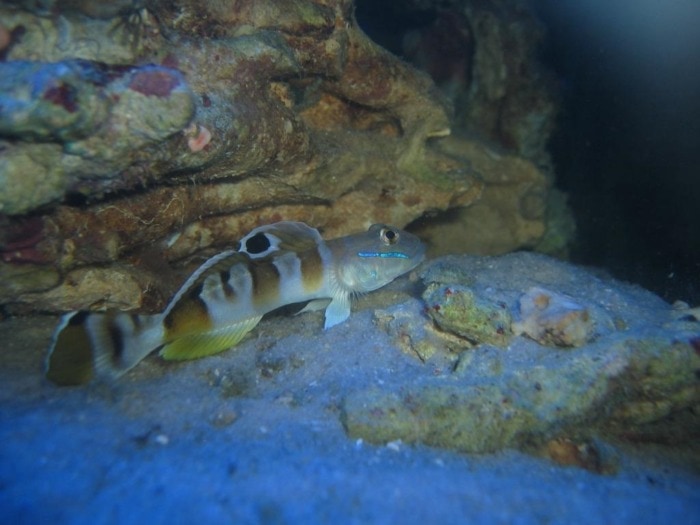
| Maximum Body Size: | close to 5 inches or around 12.7 cm |
| Minimum Tank Size: | 30 gallons, but it can handle more than 50 on its own if utilized for sifting purposes |
| Key Traits: | active; peaceful but gets territorial with its kind; hardy |
| Suitable for Beginners: | Yes |
One of the best things about the Tiger Watchman Goby fish is that it can usually release all the scooped sand in its mouth close to the substrate. These fish don’t create sandstorms like a Diamond Goby would and still manage to turn large amounts of sand in an aquarium.
I wouldn’t say that none of your corals on the bottom would get buried but, with a Tiger Watchman Goby, it’s way more manageable sand sifting.
The Tiger Watchman Goby (Valenciennea wardii) is an amazing option for medium-sized tanks, it is effective and efficient in sand sifting relative to other larger species such as Diamond Goby.
One of the salient features of the Tiger Watchman Goby is its capability to sift through sand substrate effectively. Due to its small size, it is unable to sift the entire surface of the sandbed but can process a substantial amount of sand remarkably. This keeps the surface clean and prevents detritus buildup and other dirt.
It is noticed that tiger watchman goby exhibits mild territorial behavior, especially towards conspecifics or other bottom-inhabiting fish.
While not overly aggressive, it may stake out a small territory within the aquarium and defend it against intruders. However, this interesting goby behavior is usually not problematic in well-sized tanks with ample hiding spots and territories for each fish.
Additionally, the Tiger Watchman Goby has been seen exhibiting symbiotic relationships, especially with pistol shrimp.
For these reasons, this species of Goby is a great sand-sifting creature for medium-sized marine tanks.
6. Twin Spot Goby – Signigobius biocellatus
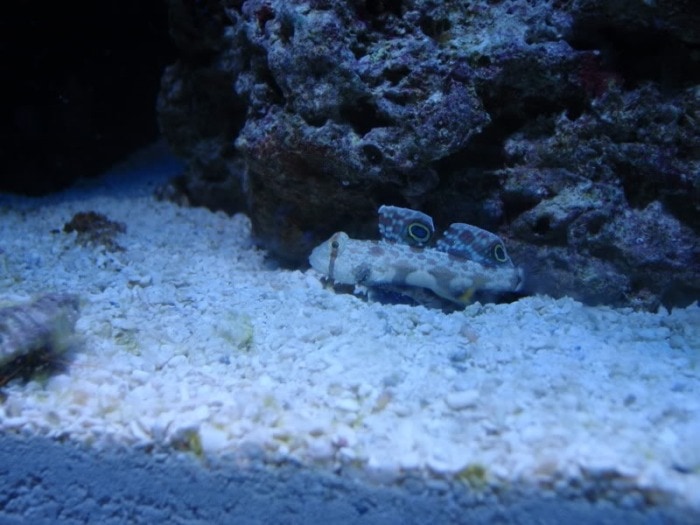
| Maximum Body Size: | 3.5 inches (8.9 cm) |
| Minimum Tank Size: | 10 gallons |
| Key Traits: | Does better in pairs; can be finicky about food; peaceful |
| Suitable for Beginners: | No |
The Twin Spot Goby, also known as a Crab-eyed Goby, is the only known member of the Signigobius genus.
The Twin Spot Goby is an exceptional sifter fish because it tends to stay near the substrate’s surface when releasing sand grains from its gills. This small spot-feeding saltwater fish is very active in digging and turning over the sandbed and does not create a mess while doing so.
The Twin Spot Goby (Signigobius biocellatus) is a surface-level sand sifter reputed for its intricate nature and feeding habits. Due to its small size, it is fit for an aquarium where minimum disruption is needed.
It is necessary to give special consideration and attention to feeding your aquarium gobies because they are delicate. While they can sift through sandbeds for small crustaceans and microorganisms, supplementary feeding is also important for overall health. Providing live or Frozen foods like brine shrimp, and finely chopped seafood is required to meet dietary needs.
The caveat with Twin Spot Gobies, however, is that they are fragile and difficult to keep alive long-term.
These sensitive goby species are vulnerable to variations in water parameters like pH, temperature, salinity, and water quality. The abrupt change in these parameters compromises the health of twin spot gobies. Therefore, it is advised to maintain stable water conditions to ensure the best health of this fish.
Temperature: Twin Spot Gobies typically survive in water temperatures ranging from 74°F to 82°F (23°C to 28°C). Changes in this temperature can have a bad impact on their health.
pH: These gobies prefer slightly alkaline water with a pH level between 8.1 and 8.4.
Salinity: Twin Spot Gobies are generally found in marine or salty environments with specific gravity ranging from 1.020 to 1.025. It’s important to maintain stable salinity levels within this range to prevent osmotic stress on the fish.
Ammonia, Nitrite, and Nitrate: These gobies are extremely sensitive to ammonia and nitrite, which need to be maintained at undetectable levels (0 ppm). Nitrate levels should be kept low, ideally below 10 ppm, as high levels can lead to health issues and immune system defects.
Keeping water quality at pristine levels is critical for the well-being of the Twin Spot goby. Poor water quality causes stress and stress-related illness in twin spot gobies.
Your sandbed may be established with copepods and amphipods and the goby may still refuse to eat from it.
If you’re experienced with spot-feeding nano fish then the Twin Spot Goby can be a good addition to your small saltwater aquarium.
Suggested read: Saltwater fish ideas for a 10-gallon aquarium
7. Sleeper Banded Goby – Amblygobius phalaena
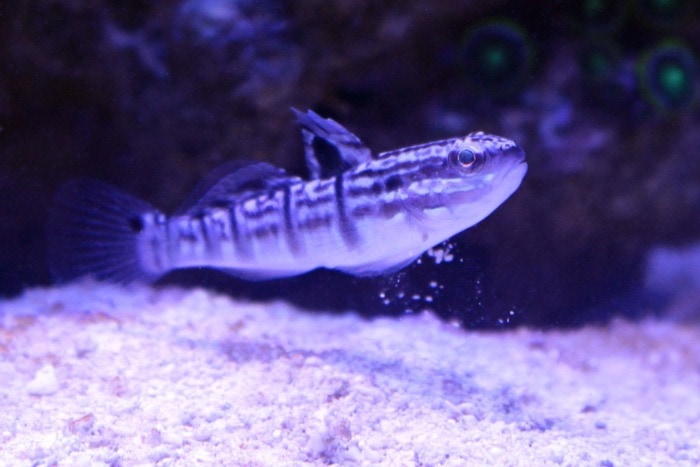
| Maximum Body Size: | 6 inches (15.24 cm) |
| Minimum Tank Size: | 30 gallons as a bare minimum |
| Key Traits: | hardy; beautiful; active; picks on algae |
| Suitable for Beginners: | Yes |
The Sleeper Banded Goby may not be as tidy when sifting through sand, but it’s one of the hardiest goby species you could find for the job.
Occasionally, this type of goby would swim roughly 5 inches off the substrate while still filtering the sand through its gills.
In comparison with the mindless digging machines from the Valenciennea genus, the Sleeper Banded Goby is a breeze in the afternoon when it comes to creating sandstorms in your aquarium.
Anyhow, keeping a Sleeper Banded Goby makes sense in larger tanks that have no corals growing on the bottom.
In this kind of setup, the goby won’t be able to create any noticeable mess.
Anyway, one great quality of the Sleeper Banded Goby is its resilience and good survival rate.
That’s because this goby fish would usually accept prepared foods.
The sleeper-banded Goby (Amblygobius phalaena) is a sturdy and efficient sand sifter, making it an excellent choice for aquariums to maintain clean substrate surfaces. They are voracious eaters of invertebrates and are also filamentous algae-eating goby, effectively controlling the growth of algae in an aquarium.
However, it sometimes shows disruptive behaviors that makes them less appropriate for small tanks with bottom corals. Nonetheless, they are recommended for larger tanks without corals or with safely positioned corals.
The Sleeper Banded Goby (Amblygobius phalaena) is highly adaptable and suitable for a variety of tank setups, making it a versatile choice for aquarium enthusiasts. Here are some key points regarding its suitability for different tank setups.
Fish-only tanks: It is suitable for fish-only tanks, and it is compatible with a variety of fish species, making it a good choice for community tanks. They can sift sand efficiently, making the substrate surface clean.
Nano Tanks: While Sleeper Banded Gobies may be better suited for larger tanks due to their occasional substrate disruption, they can still thrive in nano setups with proper care and careful considerations.
Reef -tank: Since they exhibit disruptive behavior, you need to be cautious when incorporating Sleeper Banded Gobies into reef aquariums. Generally, they are reef-safe hence posing no threat to corals or other invertebrates.
FOWLR (Fish Only with Live Rock) Tanks: They are a valuable addition to FOWLR tanks, where they aid in filtration processes by sifting through sandbeds.
These qualities make the Sleeper Banded Goby one of the best saltwater aquarium gobies for beginners.
Anyway, another great benefit of having this sand sifter in your tank is that it also picks on filamentous algae.
Don’t expect the Sleeper Banded Goby to surpass the saltwater fish best known to eat algae in efficiency, but rather consider its diet a small bonus to the overall cleaning service.
Sleeper Banded Goby (Amblygobius phalaena) is a diligent filamentous algae-eating goby, making it an excellent choice for reef aquariums seeking natural algae control.
With its gentle behavior and efficient sand-sifting abilities, it’s also an ideal beginner-friendly sand sifter, contributing to a cleaner and healthier substrate environment.
8. “Decorated” Goby – Istigobius decoratus

| Maximum Body Size: | up to 4.7 inches (12 cm) but most individuals remain at 3.6 inches (around 9 cm) when fully grown |
| Minimum Tank Size: | a 20-gallon tank |
| Key Traits: | Sifts the sand great and doesn’t make a mess, travels all around the tank, including staying on rocks, is entertaining to watch because of its personality and your guests will love it |
| Suitable for Beginners: | Yes |
I decided to include the Decorated Goby in this list because it will not send sand flying all over your tank, agitating your corals.
Speaking of corals, the Decorated Goby is a reef-safe sand sifter.
The Decorated Goby (Istigobius decorates) is an excellent addition to the aquarium, it is renowned for its effective and gentle sand-sifting abilities.
The “Decorated” Goby (Istigobius decorates) earns its name spotless sand cleaning goby due to its remarkable ability to keep sand spotless, creating a beautifully clean and pristine substrate in aquariums.
Anyway, the sand this goby moves will generally remain in the spot it decided to work on that day, as they approach sifting with finesse.
They sift close to the substrate and are not madmen like some Watchman gobies.
I’d say they are one of the best at turning over a sandbed and keeping it clean.
Another benefit of keeping a Decorated goby as sand sifters is that they don’t just stick to one place in the tank. Nor just the substrate. They like to move around the whole tank, even if it’s a very large one.
One of the most distinctive features of the Decorated Goby is its distinguished markings. Adorned with intricate patterns and colorations, consisting of shades of yellow, brown, and white, this species stands out against the sandy substrate. Its unique coloration and marking make it aesthetically appealing for aquariums.
Concerning foraging behavior, the Decorated Goby showcases marvelous traits. Primarily they are sand sifters, but they also engage in other foraging behaviors like picking at rocks and crevices to search for food. They search for crustaceans, small invertebrates making the surface clean and tidy.
It is reef-safe and compatible with a variety of corals and reef inhabitants. Its gentle reef-safe sand-sifting behavior ensures minimal disruption to the substrate and surrounding aquatic life, making it an excellent choice for reef aquariums.
This makes them an overall entertaining little fish to have in your reef tank.
Do You Really Need a Sand Goby Species in Your Tank?

Keeping one of the goby species I listed makes sense in a mature aquarium with a dirty sandbed that’s populated with microfauna.
Adding a sand-sifting goby, such as the various species available in the aquarium trade, can be highly beneficial in certain circumstances.
If your tank has a deep sandbed that needs aerating and cleaning or is covered with some form of microalgae, you’ll reap the benefits of owning one of these fish.
As aquariums progress in age, the accumulation of organic waste and uneaten food results in a decline in water quality and potential algae outbreaks. Sand-sifting gobies have the potential to reduce these issues by constantly foraging through the sand, consuming detritus and small organisms that contribute to nutrient buildup.
Speaking of which let me sum up the actual benefits of having sand sifters in your saltwater aquarium:
· sandbed aeration, releasing trapped toxic gas underneath
· Cleaning of small particles that would otherwise start to rot and cause the Nitrate levels in the tank to needlessly increase
· Culling populations of microalgae in the sandbed which could otherwise bloom
All of this is good – however, you should be tolerant of a certain degree of messiness.
It is the job of aquarists to judiciously consider the pros and cons of sand sifting gobies, to introduce a good sifter in the aquarium that causes minimum disruption, and to provide full-scale cleaning of the aquarium from detritus and other filth based on their needs.
It’s impossible to turn sand over without moving things a little or sprinkling some particles here and there.
It’s crucial to carefully evaluate the trade-off between the helpful sand-sifting behavior of gobies and the potential for sand disturbances in the aquarium, especially when building your saltwater tank cleaning crew.
While sand-sifting gobies serve as natural aquarium cleaners, aiding in sand bed maintenance by consuming detritus and small organisms, their constant digging and sifting may sometimes disrupt the substrate.
Moreover, excessive sand disturbances can release trapped gasses or toxins, emphasizing the importance of balancing sandbed maintenance with the presence of natural aquarium cleaners in your saltwater tank. Top of Form
I made sure to mention what to expect with each goby, so read carefully and think this through.
Conclusion
Sand-sifting gobies provide huge benefits to keeping and maintaining a healthy sandbed in the aquarium. These fish species are experts at sifting the sandbed, removing the detritus, filamentous algae, leftover foods, and small unwanted invertebrates from the aquarium.
To give consideration and attention to factors such as tank size, maintaining a healthy saltwater aquarium, and experience level is very important. Goby species vary in size, habits, behavior, and compatibility with other tank inhabitants, so choosing the right sand-sifting goby that is suitable for the specific setup is necessary.
Furthermore, consider your experience level as an aquarist when choosing a sand-sifting goby, as each species offers unique sand-sifting goby benefits for maintenance. Some species may need more specific care or have specific dietary needs, so it’s important to choose a goby that matches your level of experience and comfort with aquarium maintenance.
Before moving forward with your choice, make sure to evaluate if your aquarium really needs a goby species that will do nothing but constantly sift the sand.



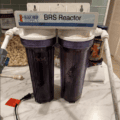
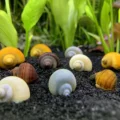


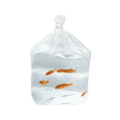
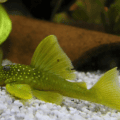
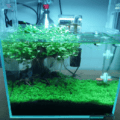
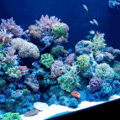
Hi am just starting marine not big my tank is a water box I only want few corals in and I have three clown fish in what sand cleaner would you recommend for my tank thanks hazel
Hi,
If you don’t want to start with sand-sifting gobies you can try invertebrates such as snails. Look up the Nassarius snails, for example.
Other than that, you can just research the compatible tank mates for the species I’ve listed in this article if they fit your new tank’s size.
Momchil